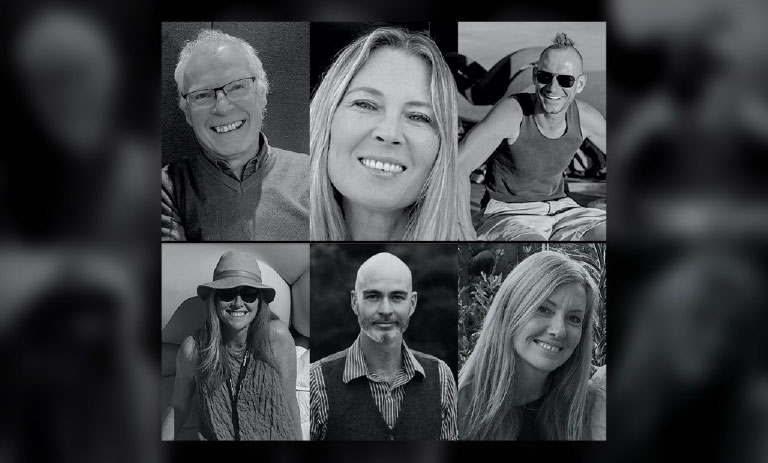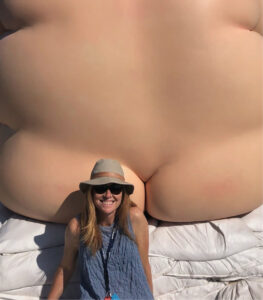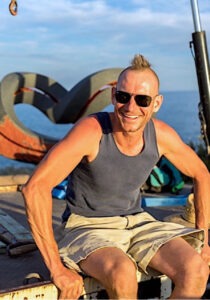
Sculpture by the Sea staff, over a decade on the job. Images: Supplied.
ArtsHub’s National Visual Arts Editor, Gina Fairley spoke with five staff who have worked for Sculpture by the Sea for over a decade, in an attempt to glean how festivals can retain and incentivise staff, despite the dread of event cycles. These are their five points of advice:
 Suzie Clark has managed the seasonal aspect of her role as Production Executive for a major sculpture festival by taking five weeks off in the middle of each year. ‘With the intensity of this job, a long break is necessary to refuel and do it all again!’ she tells ArtsHub.
Suzie Clark has managed the seasonal aspect of her role as Production Executive for a major sculpture festival by taking five weeks off in the middle of each year. ‘With the intensity of this job, a long break is necessary to refuel and do it all again!’ she tells ArtsHub.
What has sustained her interest for more than a decade on the job? ‘After a long career in theatre and film, and large-scale event production, I thought it would be easy to stage the exhibition and simply watch the people attend. But production for Sculpture by the Sea has been anything but simple or straightforward, with so many tentacles and moving parts, which I didn’t anticipate. But I wouldn’t want it any other way.’
She adds that it has ‘definitely been the lifelong friends I have made with artists, patrons and colleagues, and now my passion for art in public space,’ that has been her favourite part of working with SXS for over a decade.
And her key piece of advice? ‘There is always a solution.’
Davina Corti is SXS Company Manager (and was previously Director, Sculpture Sales and Special Projects), and like Clark, says it is ‘definitely the people,’ who have sustained her over a decade. ‘I meet and work with interesting, intelligent and fascinating people,’ she says. ‘There’s always a new idea or thought for me to explore. It’s inspirational.’
Corti says that it is the diversity that a cyclical event offers that is her favourite part of exhibition gig work. ‘Every exhibition is a completely new experience, as the artists are at different stages of their artistic careers; their practices are diverse, they work in different materials and methods of production, and their works are focused on a range of important local and global issues. They also live all around Australia and the world. Their passion and commitment is intoxicating, and it makes me want to work better for them.’
Corti adds that people often ask her what she does for the rest of the year after the exhibition closes. ‘It always amuses me,’ she tells ArtsHub. ‘In fact, most days of the year are very busy for me as I’m working with our team on our annual Cottesloe exhibition in Perth each March, then our annual Bondi exhibition and, more recently, our new Snowy Valleys Sculpture Trail in the most beautiful part of the world, only four hours from my home in Sydney.’
She says that the diversity of the events across the organisation keeps her job ‘professionally interesting’.
While many in a sculpture festival crew are outdoors and on the tools, Andrew Williams has an equally vital role as General Manager, Finance and Administration for SXS. It is not surprising then, that for him the festival ‘never really feels seasonal, except during the exhibition periods, when you are working six- and seven-day weeks of very long hours’.
For someone working in the world of accounts and finance, a sculpture festival may not be the most obvious match. However, Williams says that the organisation was a ‘very early adopter of services [and programs] like Square, Typeform, Donorbox, Stripe and Microsoft 365.’
He continues: ‘The preparation prior and the reporting post, together with all the grant proposals and acquittals, and the perpetual search for ways to do more with fewer resources and less cost, keeps the core team busy all year round.’
That all sounds serious, but Williams’ advice is: ‘Don’t take every day too seriously. Trying to responsibly manage the finances of a not-for-profit arts organisation is way harder and more stressful than working for a large for-profit corporate. I have done both.’
He adds: ‘You have to have the agility to balance your income and your expenses, often having to commit resources prior to knowing that you are going to be able to generate the income to support it. We have managed to keep going and balance the books for 27 years now, but it is a continuing challenge.
‘The thing that has kept me motivated for so many years is the concept, which allows the public to see the amazing works by artists from all over the world in such a stunning coastal location, plus the collaborative atmosphere among the team.’
Williams says his favourite part of the job, ‘is sending out the artist statements and making the payments to the artists at the final settlement of an exhibition’.
‘In the most recent financial year, we have distributed over $2.8 million to the artists from proceeds from sculpture sales, and from the awards and subsidies that we are able to offer. For many of the artists this is an essential part of their annual income, which allows them to continue their practice.’
Justin Morrissey, is no stranger to managing sculpture festivals. His first job managing a sculpture festival exhibition was in 2007, for SXS Cottesloe. ‘I was working at the time for several arts festivals on the Australian circuit, and I was blown away by the professionalism of the Sculpture by the Sea staff and sheer enormity of the project.
‘As I began to understand the artistic practice and dedication to the craft of sculpture by the many artists, I was drawn to continue working with the organisation,’ he says. Over 10 years later, Morrissey is now the Snowy Valleys Sculpture Trail Site Manager.
Across his vast experience, his key point of advice is: ‘handle artists with care!’ Morrissey adds, ‘[While] there are many benefits and challenges to working on seasonal events, there is so much work that goes on all year round behind the scenes to stage these events.’
He explains that all creatives learn how to balance the leaner times with the times ‘where there is more work than you can manage’.
Morrissey says he feels ‘fortunate to have worked on some thrilling installation projects,’ adding that his ‘favourite part of the job would have to be the fine blending of having a broad understanding of the material qualities that go into the fabrication and installations, with the wonderful characters you meet in the team and artists from all around the world.’

Yuri Humeniuk, on the job craning in sculptures for ‘Sculpture by the Sea’, Bondi. Image: Supplied.
Completing the decade-plus club of staffers with Sculpture by the Sea is Technical Consultant and Chief Installer, Yuri Humeniuk. Balancing in-office plans with out on the trail realities is a key part of Humeniuk’s everyday. Variety has sustained his interest in this work. ‘An unrivalled melting pot of people, amazing artists and technical challenges, all working together in a high-pressure, intense environment, with a great sense of achievement,’ has kept the job feeling fresh, he says.
Humeniuk continues: ‘The seasonal and sporadic nature of Sculpture by the Sea allows me to focus entirely for two weeks, and then I can go back to the real world!’
Humeniuk’s short piece of advice learned on the job? ‘Dogs are the best judges of figurative art!’